Chapter 19
Example Set 2
The following examples present the financial statements of a charity, The United States Charity.
The statements reflect that the organization was established on June 15, 2015, and selected a December 31 fiscal year-end. As a result, the Statement of Activities for the year ended December 31, 2015, includes six and one half months of operations covering the period from June 15, 2015 (inception), through December 31, 2015. The Statement of Activities for the year ended December 31, 2016, is, as is typical, for a full 12-month period.
Because of the differences in the length of time covered in 2016 and 2015, and the fact that the organization only began its operations in the middle of 2015, comparing the revenue and expenses for the two periods must be done carefully.
The Statements of Financial Position are, like all such statements, as of the close of business on the final day of the fiscal year, which is December 31, 2016 and 2015.
Example 2A: Prepared using accounting guidance before the adoption of ASU 2016-14.
Example 2B: Prepared after the adoption of ASU 2016-14.
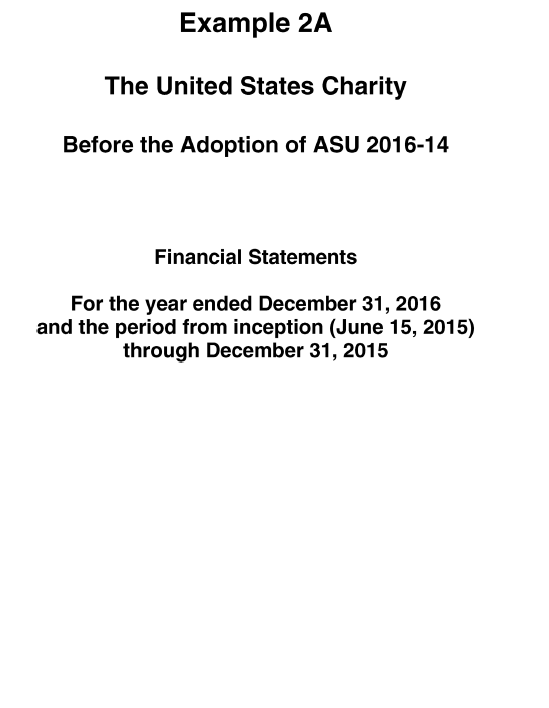
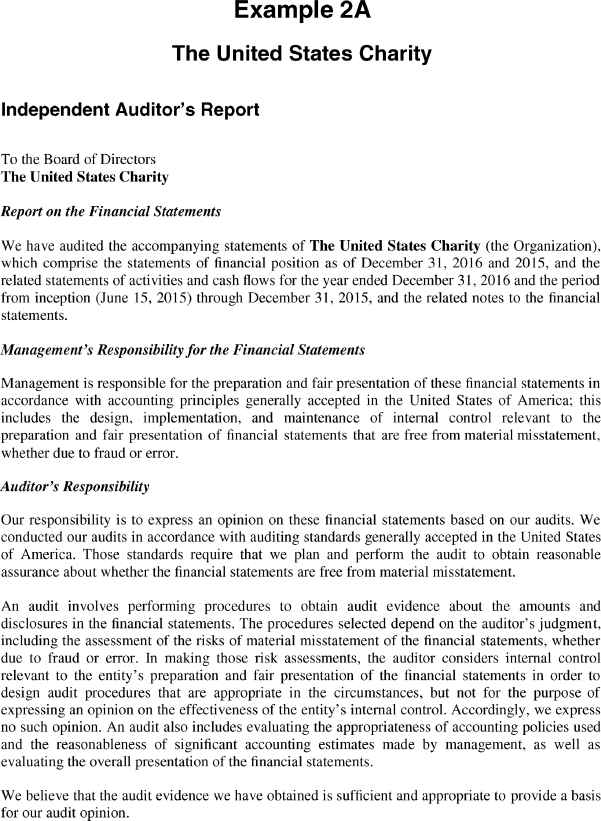
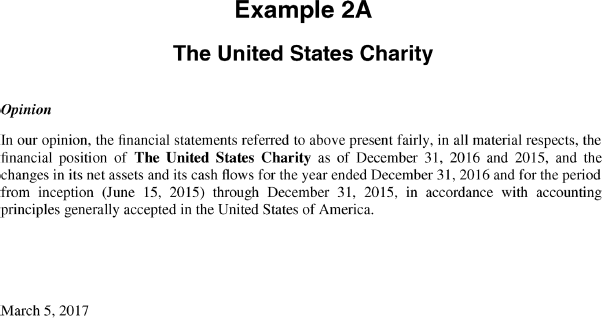
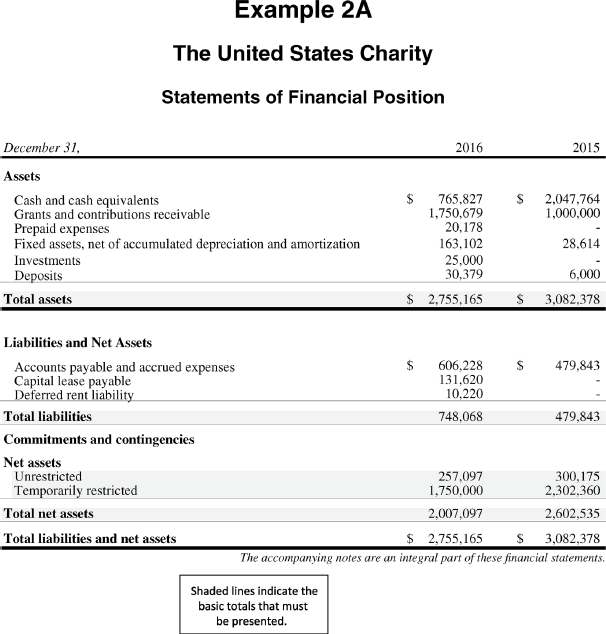
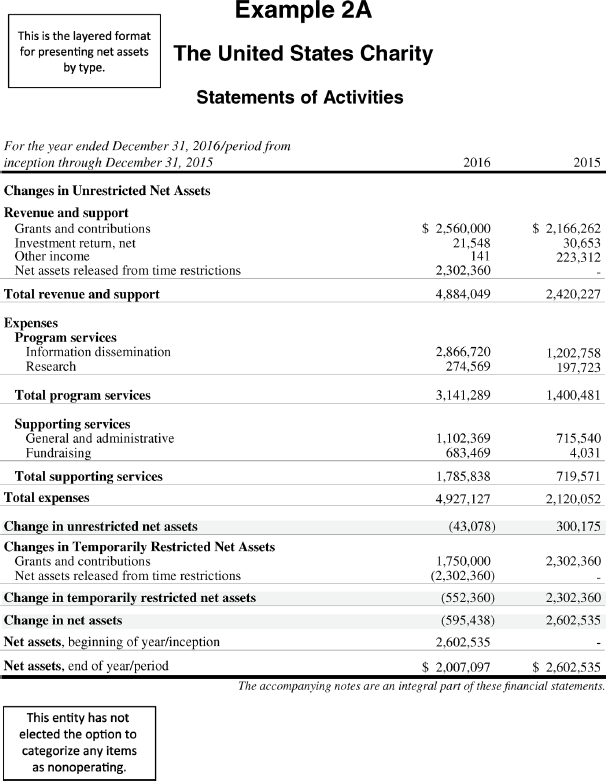
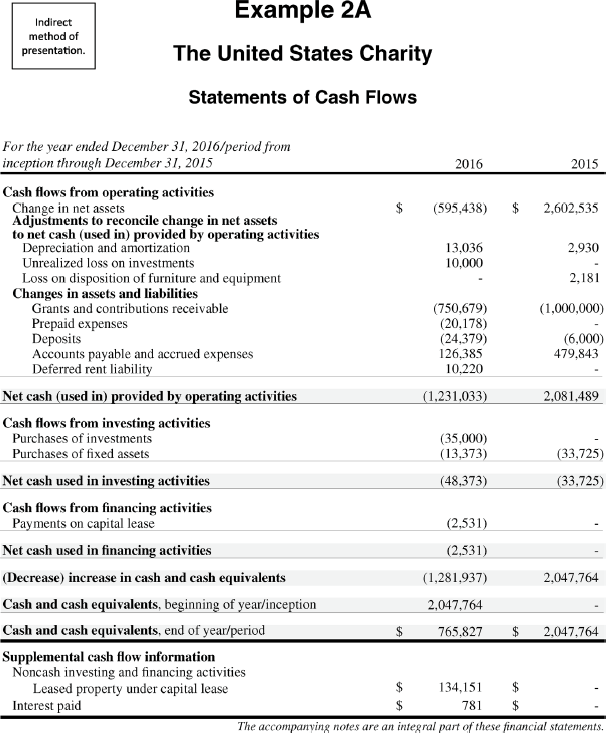
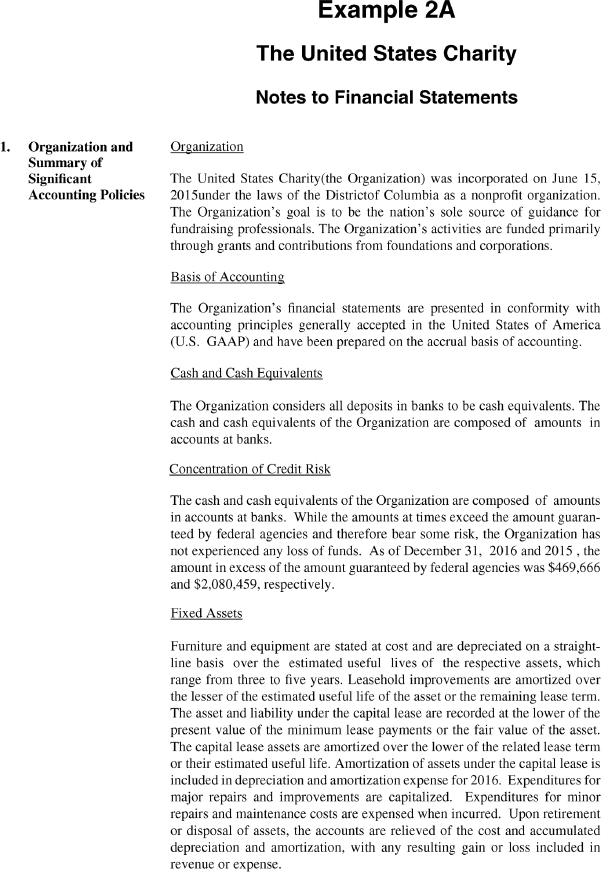
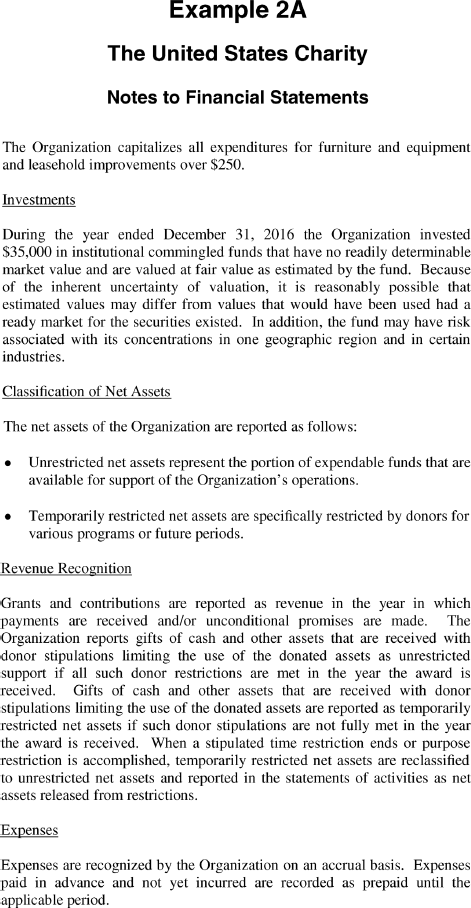
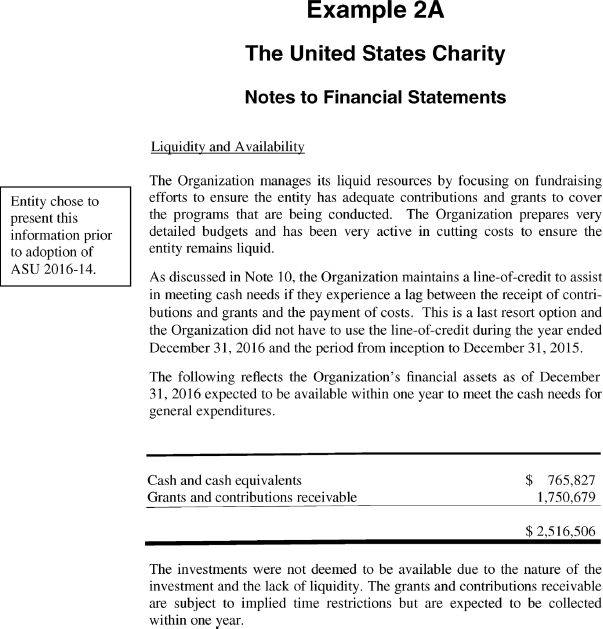
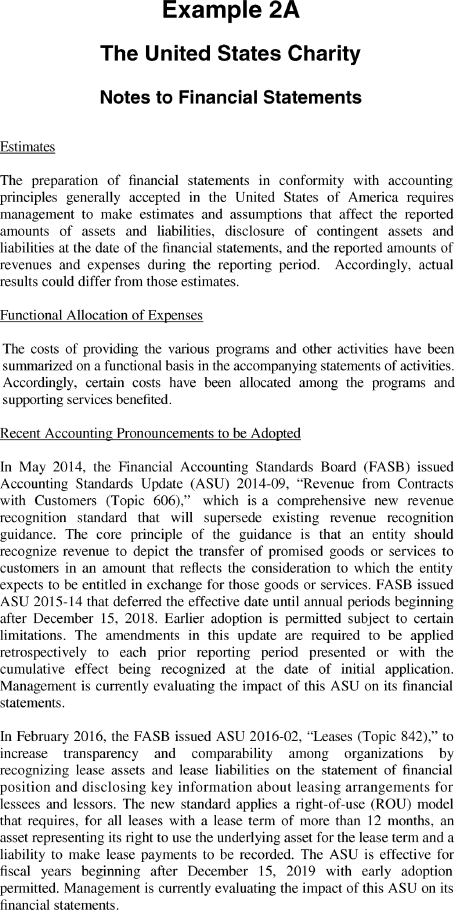
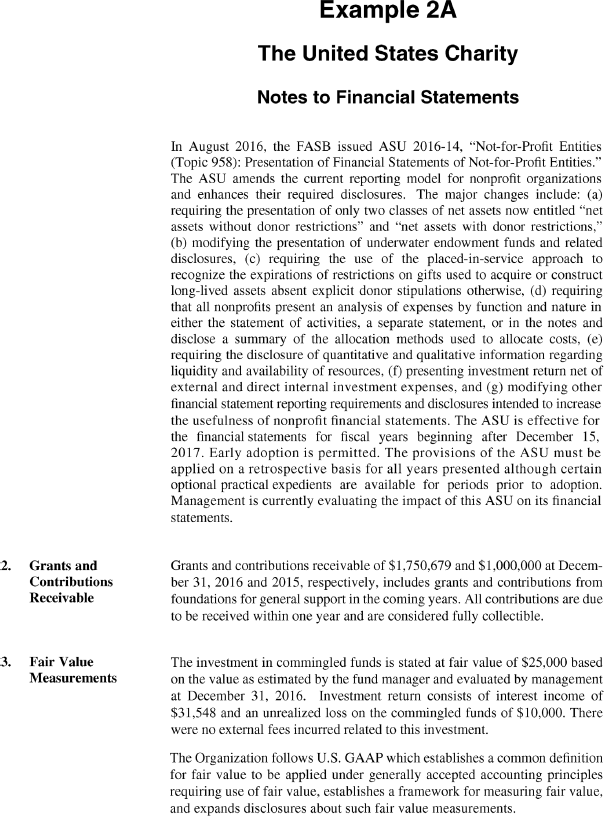
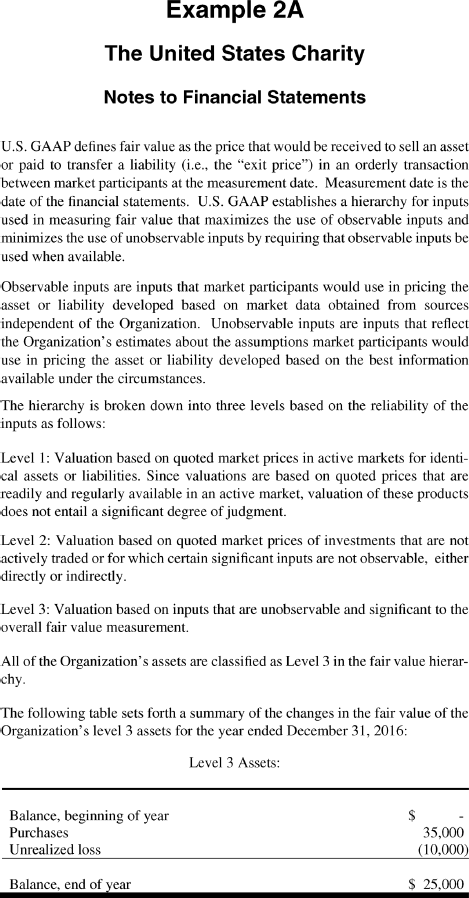
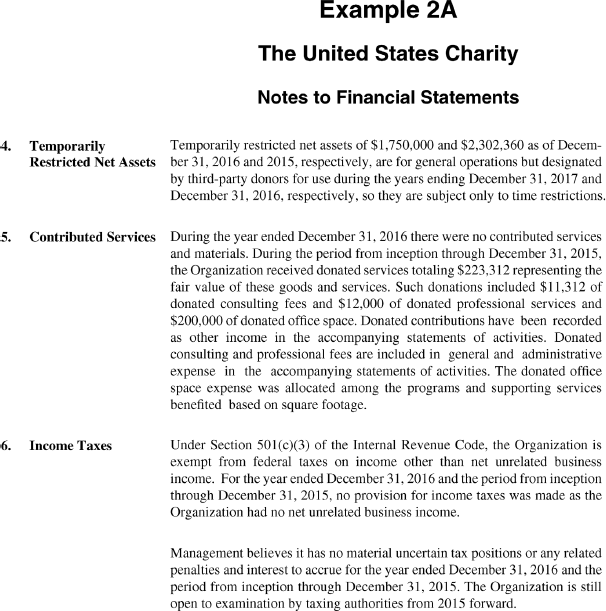
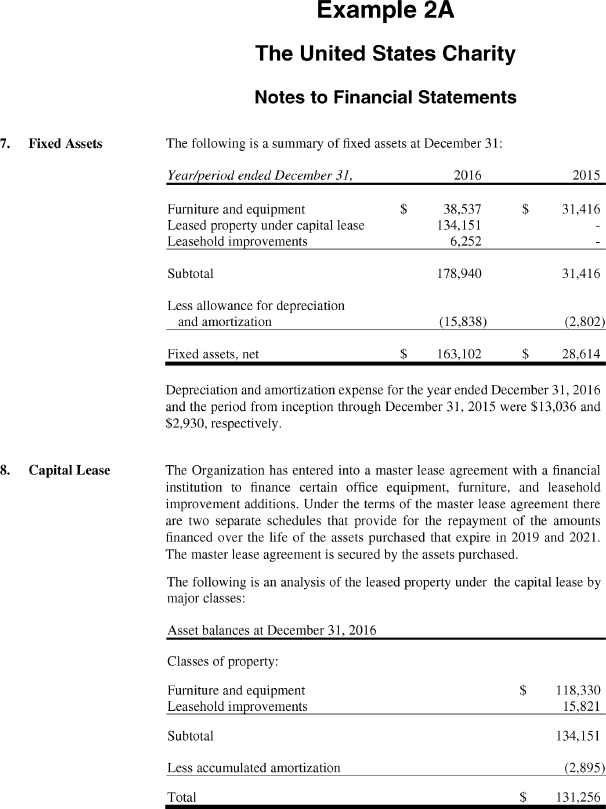
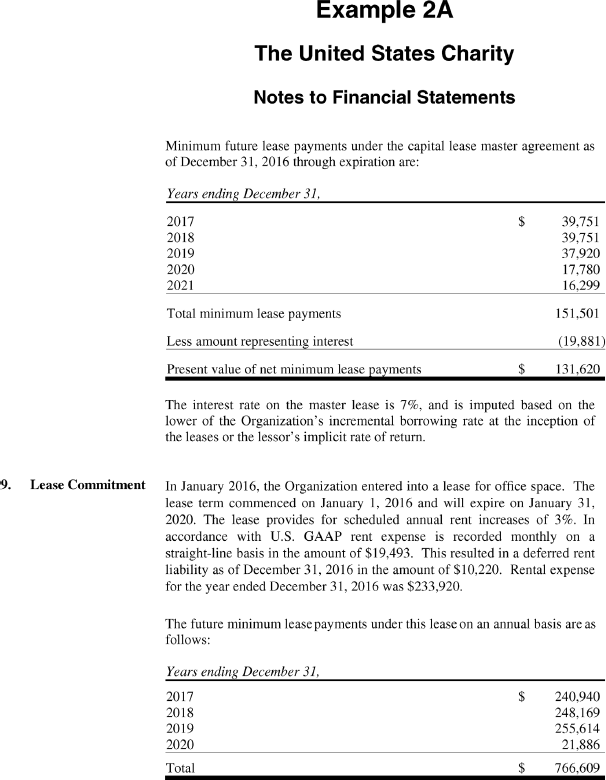
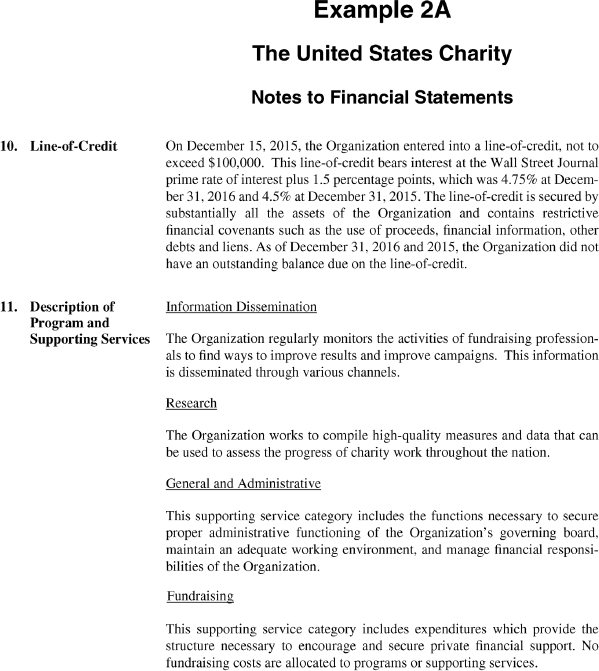
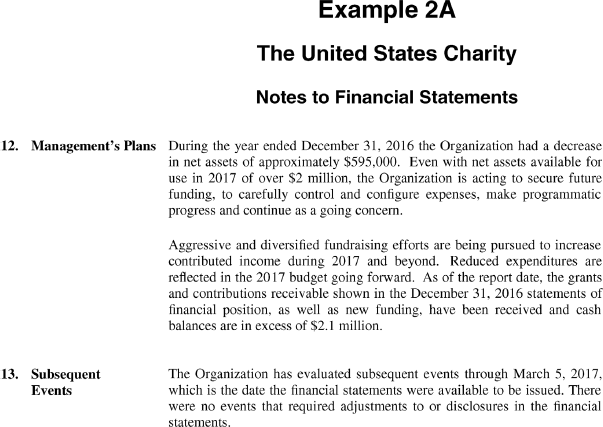
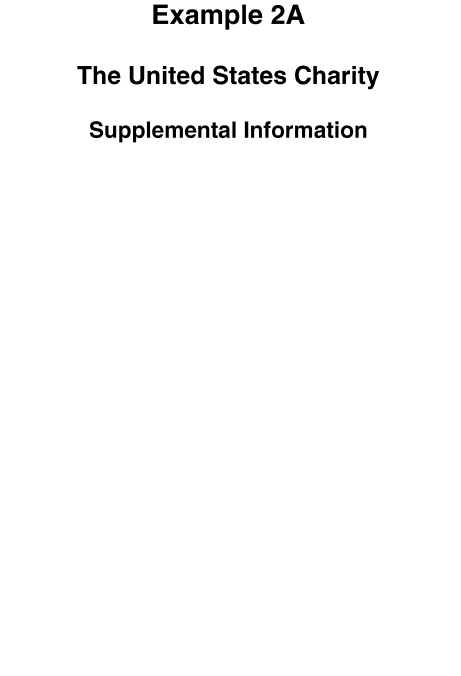
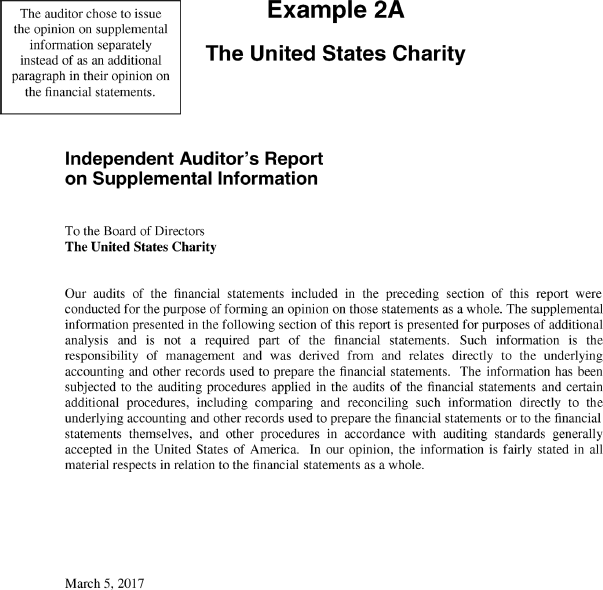
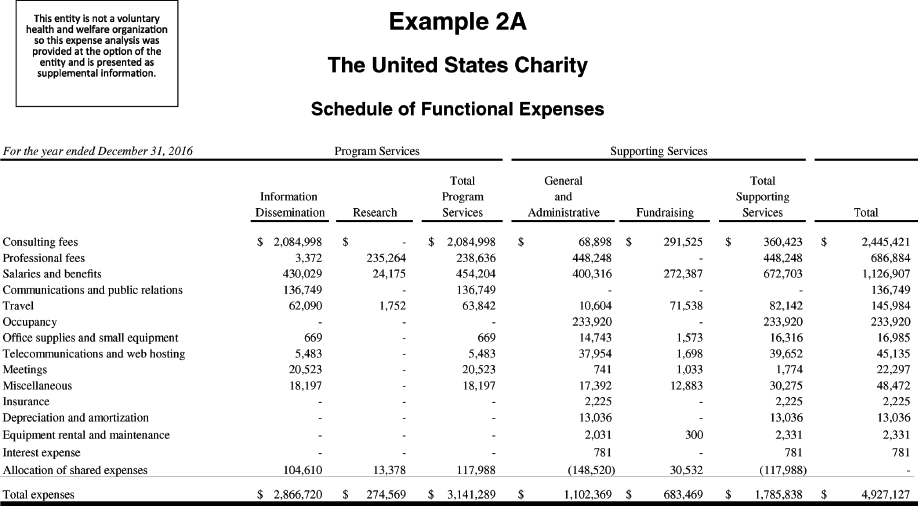
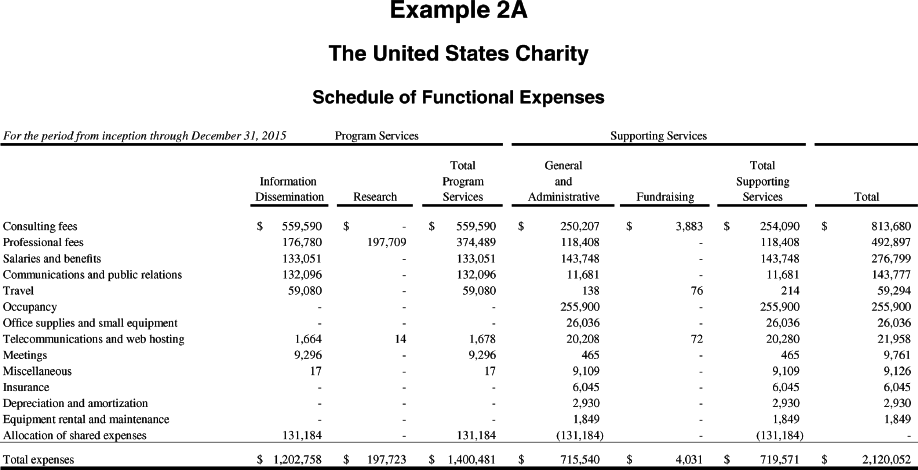
Exercise 2A: Working with Financial Statements
Use the financial statements in Example 2A for The United States Charity to familiarize yourself with a basic nonprofit financial statement.
- Begin by looking at the independent auditor's report:
- What type of opinion is this?
____________________________________________
____________________________________________
- What period is covered by the report?
____________________________________________
____________________________________________
- What type of opinion is this?
- Locate the (1) Statements of Financial Position, (2) Statements of Activities, and (3) Statements of Cash Flows:
- How much are total assets on December 31, 2016?
____________________________________________
____________________________________________
- How much cash (and cash equivalents) did the organization have on December 31, 2016? Which two statements can you use to obtain this information?
____________________________________________
____________________________________________
- How much are total liabilities on December 31, 2016?
____________________________________________
____________________________________________
- How much are total unrestricted net assets on December 31, 2016?
____________________________________________
____________________________________________
- How much are total temporarily restricted net assets on December 31, 2016?
____________________________________________
____________________________________________
- What is the organization's change in net assets (bottom line) for FY 2016?
____________________________________________
____________________________________________
- How much are total assets on December 31, 2016?
- Focusing on the Statements of Financial Position:
- What does the statement tell you about the organization's financial position as of December 31, 2016?
____________________________________________
____________________________________________
- Has the organization's liquidity improved or declined from the period ended December 31, 2015 to FY 2016?
____________________________________________
____________________________________________
- What new assets exist in FY 2016?
____________________________________________
____________________________________________
- Do you expect the organization to pay its bills when they come due?
____________________________________________
____________________________________________
- What are the organization's largest liabilities at December 31, 2016?
____________________________________________
____________________________________________
- What new liabilities has the organization incurred in FY 2016?
____________________________________________
____________________________________________
- What does the statement tell you about the organization's financial position as of December 31, 2016?
- Moving to the Statements of Activities:
- How does the total change in net assets for FY 2016 compare to the total change in net assets for the period that ended on December 31, 2015?
____________________________________________
____________________________________________
- What is this decrease attributable to?
____________________________________________
____________________________________________
- What are the key sources of revenue?
____________________________________________
____________________________________________
- Which program service is the organization's largest?
____________________________________________
____________________________________________
- How does the total change in net assets for FY 2016 compare to the total change in net assets for the period that ended on December 31, 2015?
- On to the Statements of Cash Flows:
- What method of presentation did the organization use for this statement?
____________________________________________
____________________________________________
- Did the amount of cash and cash equivalents increase or decrease during FY 2016? By how much?
____________________________________________
____________________________________________
- Which section of the statement would you look to for information on purchases of fixed assets? Did the organization spend more or less cash on purchases of fixed assets in FY 2016 than in the period that ended on December 31, 2015?
____________________________________________
____________________________________________
- Which section of the statement would you look to for information on purchases of investments? Did the organization spend more or less cash on purchases of investments in FY 2016 than in the period that ended on December 31, 2015?
____________________________________________
____________________________________________
- How did the investments fare in the current economy? Where did you find this information?
____________________________________________
____________________________________________
- Why are the lease obligation and the asset capitalized under the capital lease not shown in the main part of the statement?
____________________________________________
____________________________________________
- What method of presentation did the organization use for this statement?
- And do not forget the footnotes:
- Where can you find information regarding all the significant accounting policies used by the organization?
____________________________________________
_______
- Where can you find information that discusses management's plans related to the current decline in revenue and the decrease in net assets?
____________________________________________
____________________________________________
- What use are the FY 2016 temporarily restricted net assets designated for? Where did you find this information?
____________________________________________
____________________________________________
- Where can you find information regarding all the significant accounting policies used by the organization?
- And finally, examine the Supplemental Information:
- What is the title of the supplemental schedule?
____________________________________________
____________________________________________
- What are the total professional fees in FY 2016? Where did you find this information?
____________________________________________
____________________________________________
- What was the total expense related to the Information Dissemination program in FY 2016? Which two statements can you obtain this information from?
____________________________________________
____________________________________________
- What is the title of the supplemental schedule?
- Among the most important issues revealed by the financial statements are the following:
- ____________________________________________
- ____________________________________________
Exercise 2A: Answers
- Begin by looking at the independent auditor's report:
- What type of opinion is this?
Unmodified.
- What period is covered by the report?
The year ending December 31, 2016, and the period from inception (June 15, 2015) through December 31, 2015.
- What type of opinion is this?
- Locate the (1) Statements of Financial Position, (2) the Statements of Activities, and (3) the Statements of Cash Flows:
- How much are total assets on December 31, 2016?
$2,755,165.
- How much cash (and cash equivalents) did the organization have on December 31, 2016? Which two statements can you use to obtain this information?
$765,827. Statements of Financial Position and Statements of Cash Flows.
- How much are total liabilities on December 31, 2016?
$748,068.
- How much are total unrestricted net assets on December 31, 2016?
$257,097.
- How much are total temporarily restricted net assets on December 31, 2016?
$1,750,000.
- What is the organization's change in net assets (bottom line) for FY 2016?
$(595,438).
- How much are total assets on December 31, 2016?
- Focusing on the Statements of Financial Position:
- What does the statement tell you about the organization's financial position as of December 31, 2016?
This statement tells you, among other things, that the organization's assets exceed its Ansliabilities, and that its net assets have declined in FY 2016.
- Has the organization's liquidity improved or declined from the period ended December 31, 2015 to FY 2016?
The organization's liquidity has declined from 2015 to 2016 since the organization has less cash available to satisfy their liabilities, which have increased.
- What new assets exist in FY 2016?
Prepaid expenses and investments.
- Do you expect the organization to pay its bills when they come due?
Yes. The organization currently has sufficient cash to meet its liabilities.
- What are the organization's largest liabilities at December 31, 2016?
Accounts payable and accrued expenses of $606,228.
- What new liabilities has the organization incurred in FY 2016?
Capital lease payable and deferred rent liability.
- What does the statement tell you about the organization's financial position as of December 31, 2016?
- Moving to the Statements of Activities:
- How does the total change in nets assets for FY 2016 compare to the total change in net assets for the period that ended on December 31, 2015?
There has been a large decrease in the change in net assets between these dates. The period that ended on December 31, 2015, had a positive change in net assets of $2,602,535, and the year that ended December 31, 2016, had a negative change in net assets of $(595,438).
- What is this decrease attributable to?
The organization has experienced a decline in grants and contributions overall (need to consider the total of unrestricted and temporarily restricted grants and contributions), and expenses have increased sharply even as revenue has decreased.
- What are the key sources of revenue?
Grants and contributions.
- Which program service is the organization's largest?
Information dissemination.
- How does the total change in nets assets for FY 2016 compare to the total change in net assets for the period that ended on December 31, 2015?
- On to the Statements of Cash Flows:
- What method of presentation did the organization use for this statement?
Indirect method.
- Did the amount of cash and cash equivalents increase or decrease during FY 2016? By how much?
Decreased by $(1,281,937).
- Which section of the statement would you look to for information on purchases of fixed assets? Did the organization spend more or less cash on purchases of fixed assets in FY 2016 than in the period that ended on December 31, 2015?
Cash flows from investing activities section. Less was spent in FY 2016. The organization spent $13,373 during the year that ended on December 31, 2016, and $33,725 in the period that ended on December 31, 2015.
- Which section of the statement would you look to for information on purchases of investments? Did the organization spend more or less cash on purchases of investments in FY 2016 than in the period that ended on December 31, 2015?
Cash flows from investing activities section. The organization spent more in FY 2016. The organization spent $35,000 for the year that ended on December 31, 2016, and none for the period that ended on December 31, 2015.
- How did the investments fare in the current economy? Where did you find this information?
There was an unrealized loss of $(10,000) per the adjustment section under Operating Activities in the Statements of Cash Flows and in Note 3.
- Why are the lease obligation and the asset capitalized under the capital lease not shown in the main part of the statement?
This is a noncash transaction since debt was exchanged for the assets. No cash was involved, so this is disclosed in the supplemental cash flow information that can be presented on the statement or in the footnotes.
- What method of presentation did the organization use for this statement?
- And do not forget the footnotes:
- Where can you find information regarding all the significant accounting policies used by the organization?
Note 1—Organization and Summary of Significant Accounting Policies.
- Where can you find information that discusses management's plans related to the current decline in revenue and the decrease in net assets?
Note 12.
- What use are the FY 2016 temporarily restricted net assets designated for? Where do you find this information?
They are for general operations. They are only time restricted for 2017 per Note 4.
- Where can you find information regarding all the significant accounting policies used by the organization?
- And finally, examine the Supplemental Information:
- What is the title of the supplemental schedule?
Schedule of Functional Expenses.
- What are the total professional fees in FY 2016? Where did you find this information?
$686,884. Supplemental Schedule of Functional Expenses.
- What was the total expense related to the Information Dissemination program in FY 2016? Which two statements can you obtain this information from?
$2,866,720. This can be found in both the Statements of Activities and the Supplemental Schedule of Functional Expenses.
- What is the title of the supplemental schedule?
- Among the most important issues revealed by the financial statements are the following:
- This statement is a challenge to analyze, not only because the periods of operation differ but also because The United States Charity receives both unrestricted and temporarily restricted revenue.
- As mentioned earlier in the materials, temporarily restricted revenue and expenses must be accounted for separately in the Statements of Activities. In this statement, a “layered” approach is used: unrestricted revenue and expenses are reported on initially, leading to a change in unrestricted net assets. Then temporarily restricted income is reported, with a resulting change in temporarily restricted net assets. The two changes in net assets are then summarized for a change in net assets for the organization as a whole.
- It is important to remember when reading this statement that accounting principles generally accepted in the United States of America (U.S. GAAP) requires that all expenses be treated as having been distributed from unrestricted net assets. To make this work, the temporarily restricted net assets that have been expended are released from the portion of the statement dealing with temporarily restricted net assets, thus reducing temporarily restricted net assets. They are simultaneously added to the revenue section of the unrestricted net assets.
- All of this aside, what of importance has happened? The best place to start is to look at the total change in net assets, which is the third line up from the bottom of the Statements of Activities. In the 2015 short fiscal year, the organization had a positive $2.6M increase in net assets, while in the full 2016 fiscal year, the organization lost $(595K). Clearly, things went seriously wrong and the board and management need to be very attentive.
- If we look at key revenue sources and expenses, the mathematics is fairly straightforward: unrestricted grants and contributions are up approximately $400K, while temporarily restricted grants and contributions are actually down by approximately $(550K). This is a net reduction of $(150K). Meanwhile, fundraising costs went from $4K to $683K, an enormous increase. This critical source of revenue had apparently been easily found at the start of the charity's existence, but became critically more difficult to acquire in its first full year of operations.
- As this was going on, the organization went about substantially increasing its programs and substantially increasing its general and administrative services for the full year that ended on December 31, 2016 ($1.7M and $387K, respectively). By reviewing the additional information provided in the Supplemental Schedules of Functional Expenses, it is possible to determine consultant fees more than tripled (from $814K to $2.4M) and that salary and benefits nearly quadrupled (from $277K to $1.1M). If the organization is to survive, these costs must be brought under control.
- The net result of all of this on the organization as a whole was a change from the 2015 short fiscal year positive change in net assets of $2.6M to a FY 2016 loss of $(595K). In Note 12, management has noted that they are addressing the issue of the decline in net assets and outline the steps they are taking to secure future funding and reductions in expenses for FY 2017 and beyond.
- The precipitous decline affected the Statements of Financial Position in a number of ways. Most obviously, the cash position dropped by well over half ($2M to $765K), taking an excellent liquidity situation at the end of the short 2015 fiscal period and making it considerably weaker at the end of FY 2016. Overall, total assets dropped by $(327K), while liabilities increased $268K.
- The Statements of Cash Flows also provides some absolutely critical information for the organization. For a young organization, having cash provided by operations is always excellent. In the short year that ended on December 31, 2015, operations added more than $2M—a very positive sign. Unfortunately, for the full year that ended on December 31, 2016, operations consumed more than $1.2M. It is information like this that can make the Statements of Cash Flows useful to review.
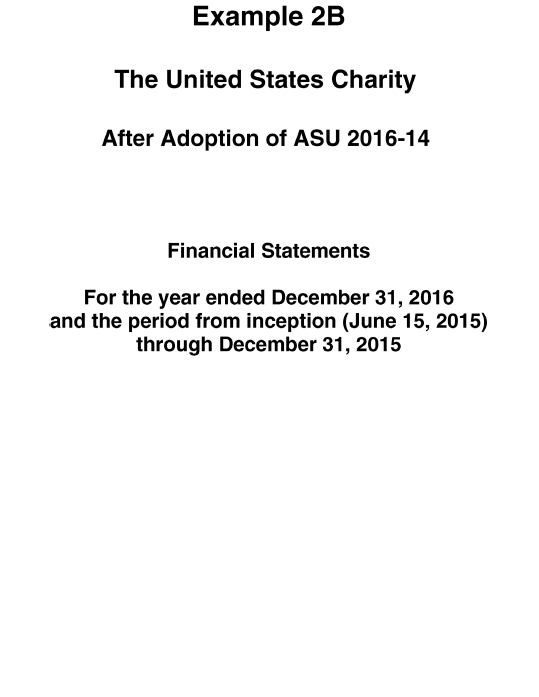
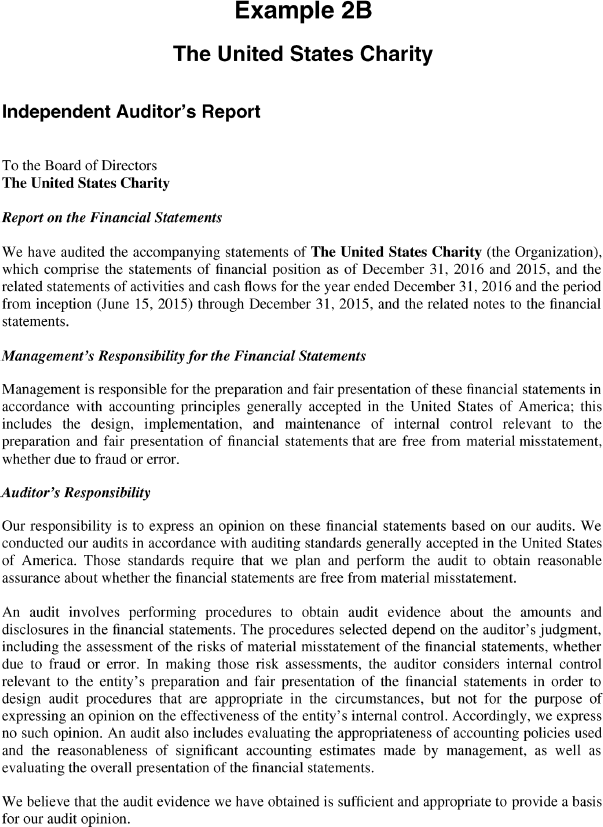
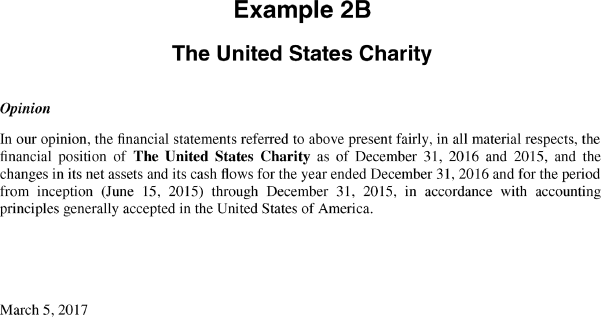
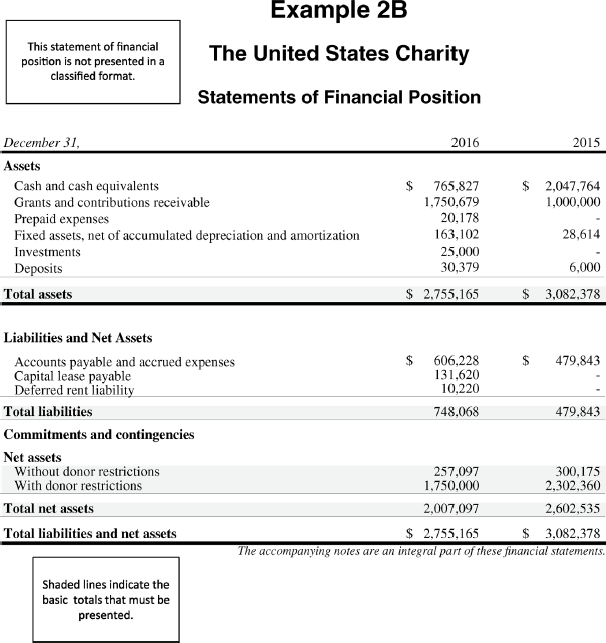
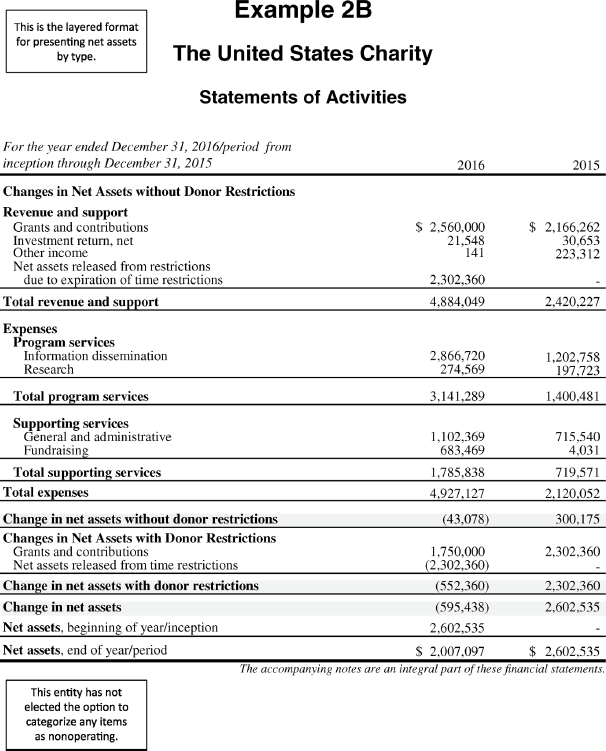
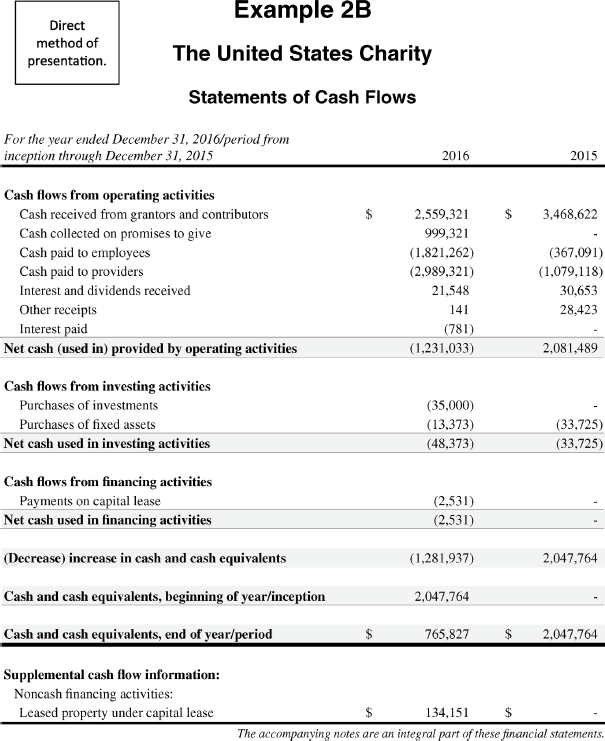
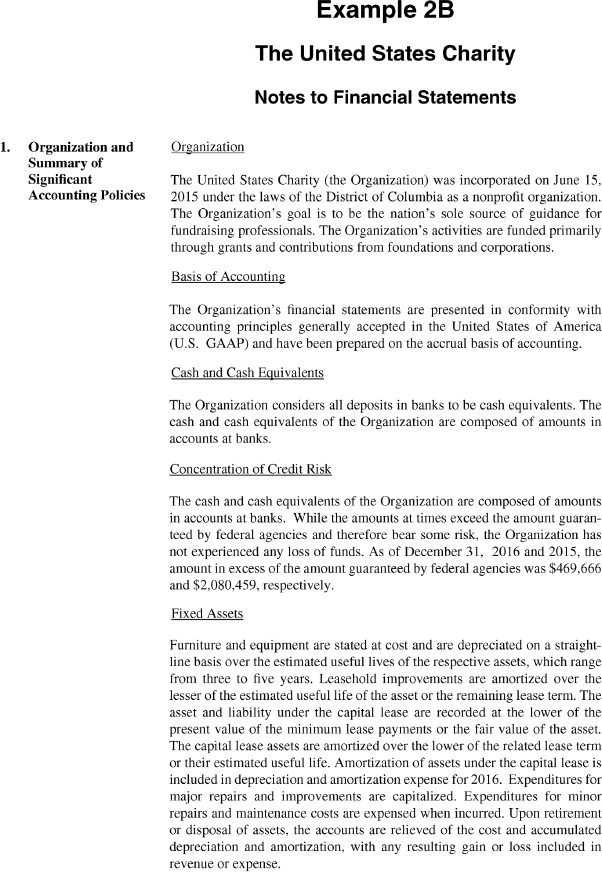
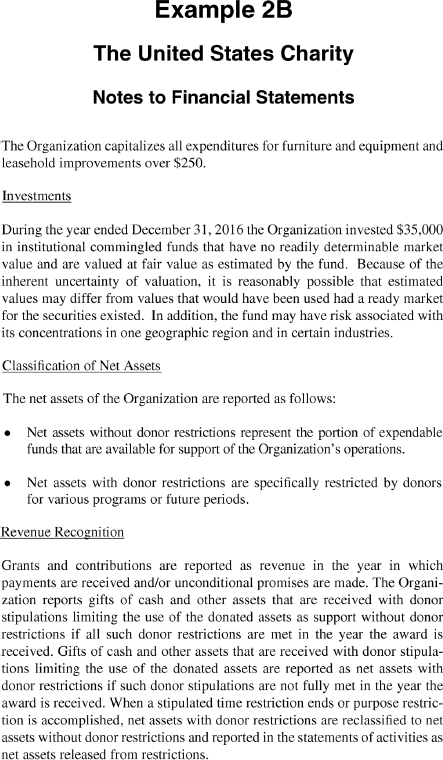
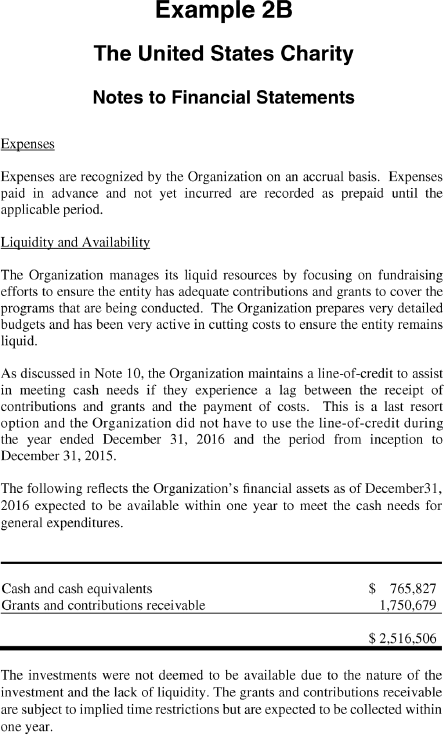
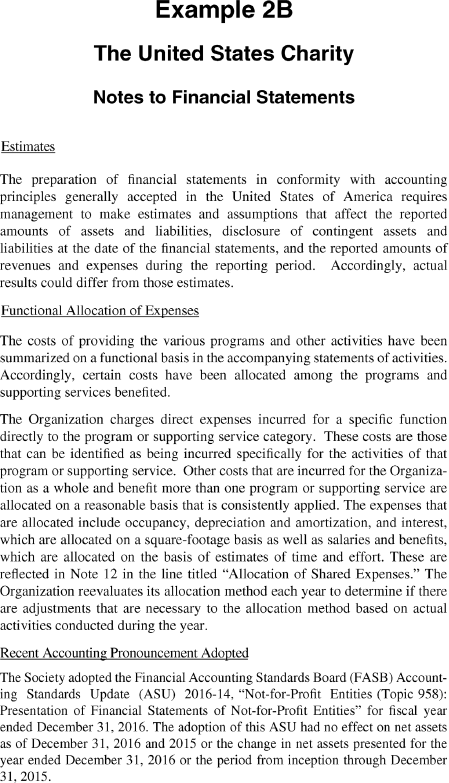
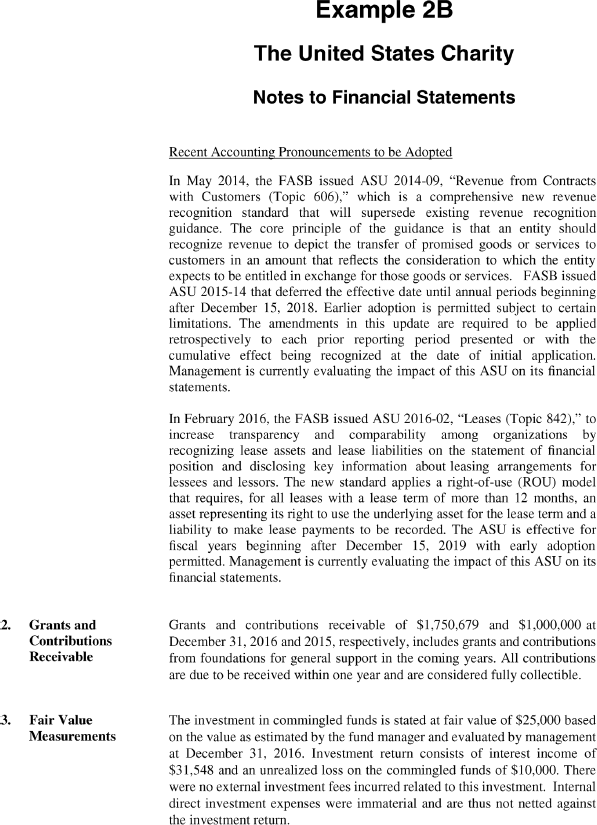
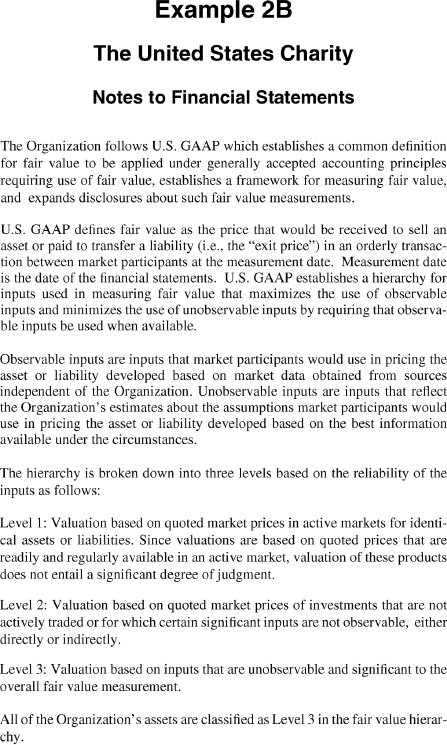
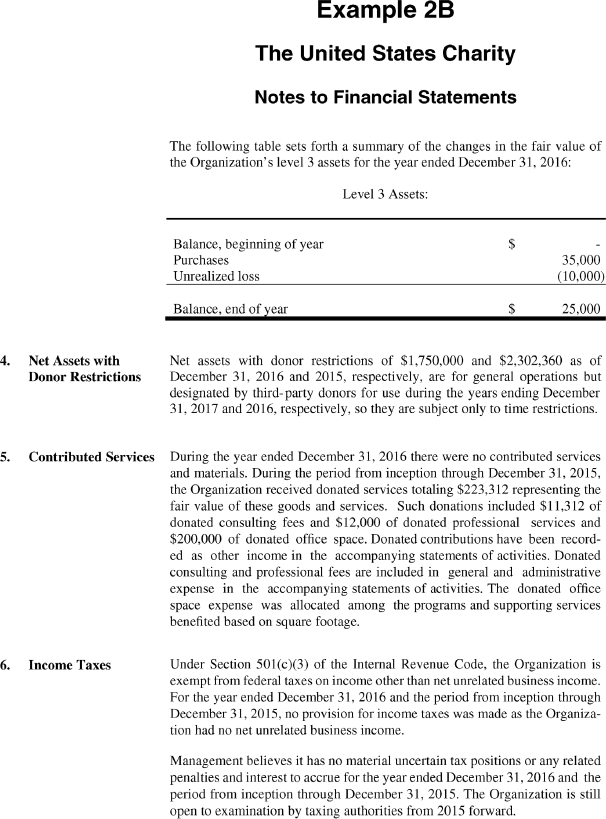
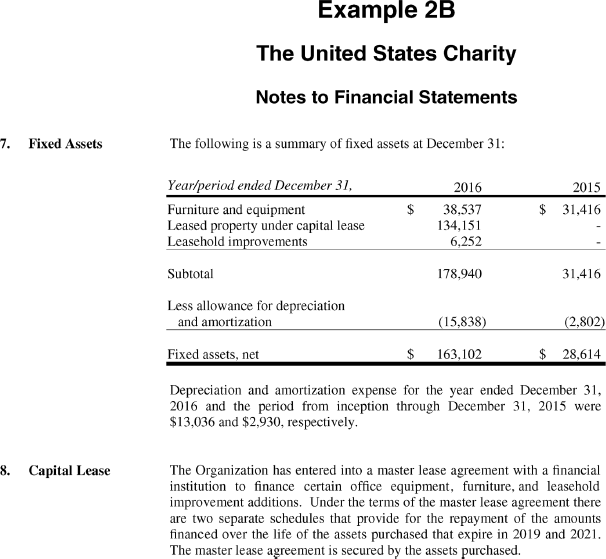
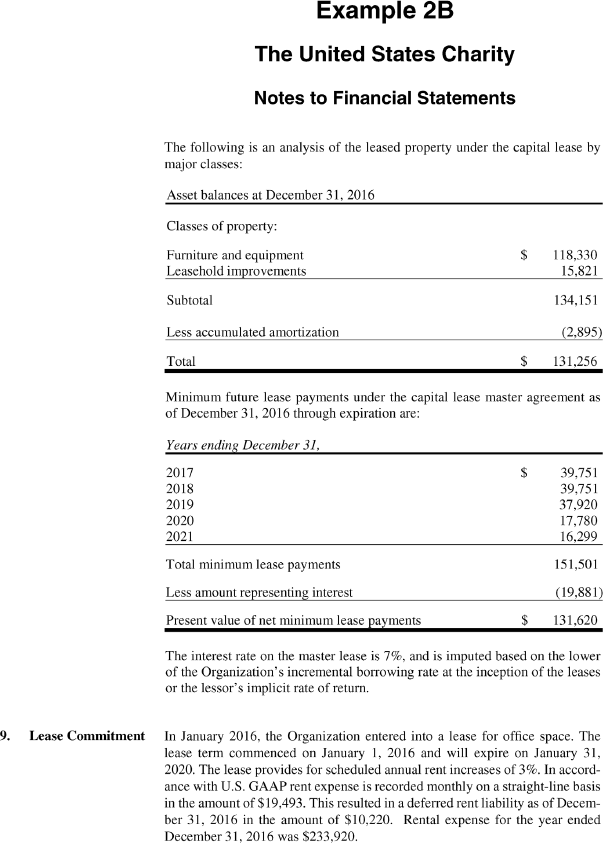
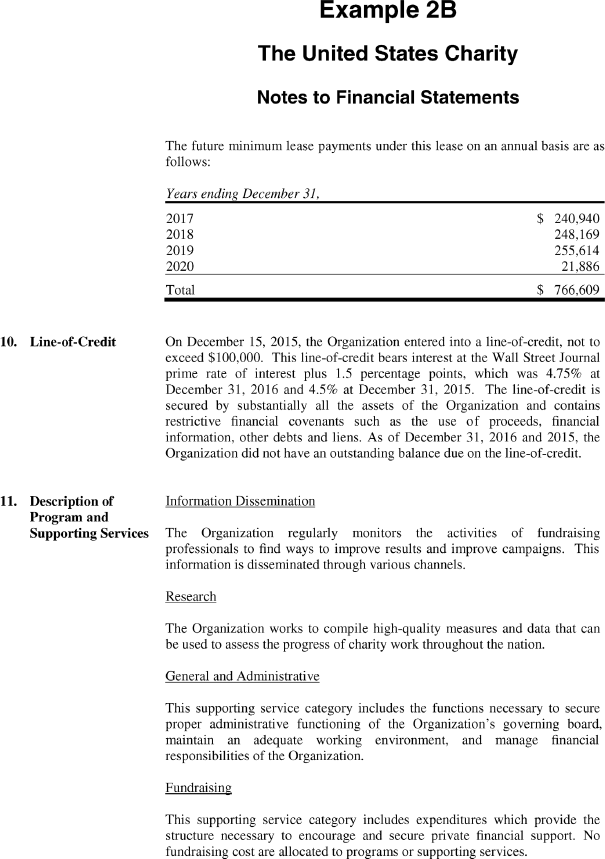
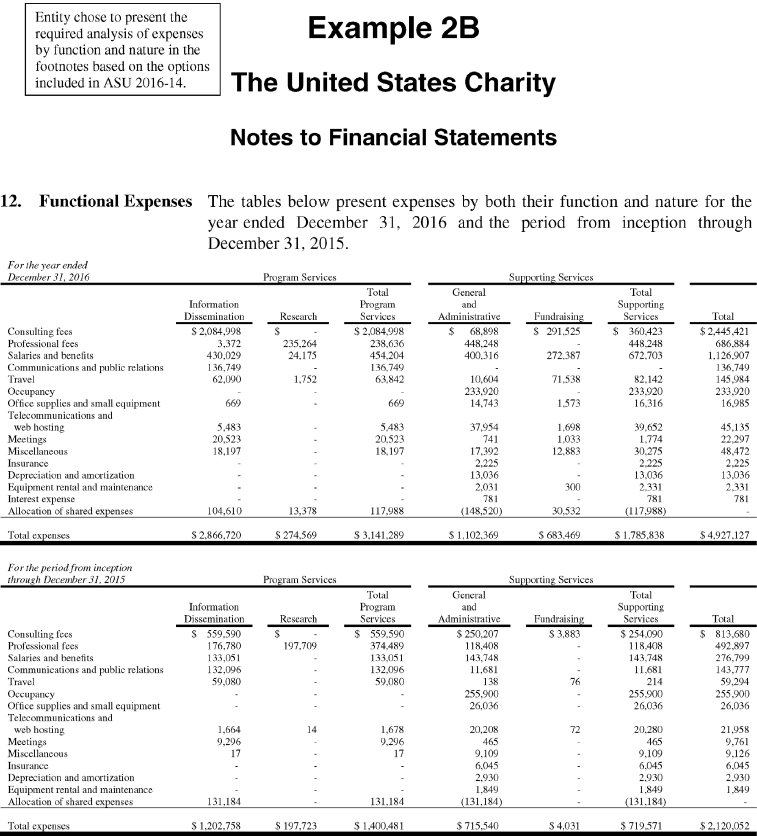
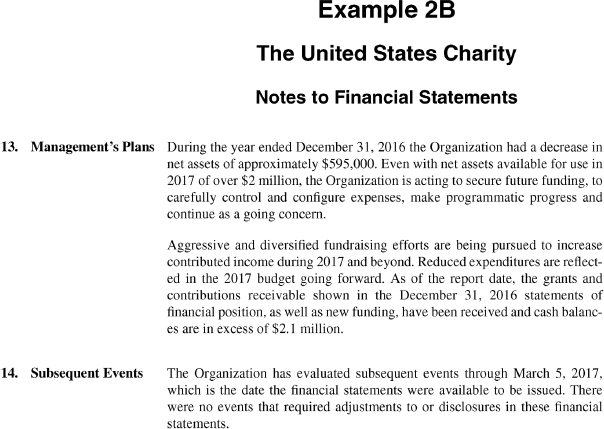
Exercise 2B: Working with Financial Statements
Use the financial statements in Example 2B for The United States Charity to familiarize yourself with a basic nonprofit financial statement.
- Begin by looking at the independent auditor's report:
- What type of opinion is this?
____________________________________________
____________________________________________
- What period is covered by the report?
____________________________________________
____________________________________________
- What type of opinion is this?
- Locate the (1) Statements of Financial Position, (2) Statements of Activities, and (3) Statements of Cash Flows:
- How much are total assets on December 31, 2016?
____________________________________________
____________________________________________
- How much cash (and cash equivalents) did the organization have on December 31, 2016? Which two statements can you use to obtain this information?
____________________________________________
____________________________________________
- How much are total liabilities on December 31, 2016?
____________________________________________
____________________________________________
- How much are total net assets without donor restrictions on December 31, 2016?
____________________________________________
____________________________________________
- How much are total net assets with donor restrictions on December 31, 2016?
____________________________________________
____________________________________________
- What is the organization's change in net assets (bottom line) for FY 2016?
____________________________________________
____________________________________________
- How much are total assets on December 31, 2016?
- Focusing on the Statements of Financial Position:
- What does the statement tell you about the organization's financial position as of December 31, 2016?
____________________________________________
____________________________________________
- Has the organization's liquidity improved or declined from the period that ended on December 31, 2015 to FY 2016?
____________________________________________
____________________________________________
- What new assets exist in FY 2016?
____________________________________________
____________________________________________
- Do you expect the organization to pay its bills when they come due?
____________________________________________
____________________________________________
- What are the organization's largest liabilities on December 31, 2016?
____________________________________________
____________________________________________
- What new liabilities has the organization incurred in FY 2016?
____________________________________________
____________________________________________
- What does the statement tell you about the organization's financial position as of December 31, 2016?
- Moving to the Statements of Activities:
- How does the total change in net assets for FY 2016 compare to the total change in net assets for the period that ended on December 31, 2015?
____________________________________________
____________________________________________
- What is this decrease attributable to?
____________________________________________
____________________________________________
- What are the key sources of revenue?
____________________________________________
____________________________________________
- Which program service is the organization's largest?
____________________________________________
____________________________________________
- How does the total change in net assets for FY 2016 compare to the total change in net assets for the period that ended on December 31, 2015?
- On to the Statements of Cash Flows:
- What method of presentation did the organization use for this statement?
____________________________________________
____________________________________________
- Which section of the statement would you look to for information on purchases of fixed assets? Did the organization spend more or less cash on purchases of fixed assets in FY 2016 than in the period that ended on December 31, 2015?
____________________________________________
____________________________________________
- Which section of the statement would you look to for information on purchases of investments? Did the organization spend more or less cash on purchases of investments in FY 2016 than in the period that ended on December 31, 2015?
____________________________________________
____________________________________________
- Why are the lease obligation and the asset capitalized under the capital lease not shown in the main part of the statement?
____________________________________________
____________________________________________
- What method of presentation did the organization use for this statement?
- And do not forget the footnotes:
- Where can you find information regarding all the significant accounting policies used by the organization?
____________________________________________
____________________________________________
- Where can you find information that discusses management's plans related to the current decline in revenue and the decrease in net assets?
____________________________________________
____________________________________________
- What use are the FY 2016 net assets with donor restrictions designated for? Where did you find this information?
____________________________________________
____________________________________________
- What are the total professional fees in FY 2016?
____________________________________________
____________________________________________
- What was the total expense related to the Information Dissemination program in FY 2016?
____________________________________________
____________________________________________
- Where can you find information regarding all the significant accounting policies used by the organization?
- Which components of the financial statements reflect the adoption of ASU 2016-14?
- ____________________________________________
- ____________________________________________
- Among the most important issues revealed by the financial statements are the following:
- ____________________________________________
- ____________________________________________
Exercise 2B: Answers
- Begin by looking at the auditor's report:
- What type of opinion is this?
Unmodified.
- What period is covered by the report?
The year ending December 31, 2016, and the period from inception (June 15, 2015) through December 31, 2015.
- What type of opinion is this?
- Locate the (1) Statements of Financial Position, (2) the Statements of Activities, and (3) the Statements of Cash Flows:
- How much are total assets on December 31, 2016?
$2,755,165.
- How much cash (and cash equivalents) did the organization have on December 31, 2016? Which two statements can you use to obtain this information?
$765,827. Statements of Financial Position and Statements of Cash Flows.
- How much are total liabilities on December 31, 2016?
$748,068.
- How much are total net assets without donor restrictions on December 31, 2016?
$257,097.
- How much are total net assets with donor restrictions on December 31, 2016?
$1,750,000.
- What is the organization's change in net assets (bottom line) for FY 2016?
$(595,438).
- How much are total assets on December 31, 2016?
- Focusing on the Statements of Financial Position:
- What does the statement tell you about the organization's financial position as of December 31, 2016?
This statement tells you, among other things, that the organization's assets exceed its liabilities, and that its net assets have declined in FY 2016.
- Has the organization's liquidity improved or declined from the period that ended on December 31, 2015 to FY 2016?
The organization's liquidity has declined from 2015 to 2016 since the organization has less cash available to satisfy its liabilities, which have increased.
- What new assets exist in FY 2016?
Prepaid expenses and investments.
- Do you expect the organization to pay its bills when they come due?
Yes. The organization currently has sufficient cash to meet its liabilities.
- What are the organization's largest liabilities?
Accounts payable and accrued expenses of $606,228.
- What new liabilities has the organization incurred in FY 2016?
Capital lease payable and deferred rent liability.
- What does the statement tell you about the organization's financial position as of December 31, 2016?
- Moving to the Statements of Activities:
- How does the total change in net assets for FY 2016 compare to the total change in net assets for the period that ended on December 31, 2015?
There has been a large decrease in the change in net assets between these dates. The period that ended on December 31, 2015, had a positive change in net assets of $2,602,535, and the year that ended December 31, 2016, had a negative change in net assets of $(595,438).
- What is this decrease attributable to?
The organization has experienced a decline in grants and contributions overall (need to consider the total of contributions without donor restrictions and contributions with donor restrictions), and expenses have increased sharply even as revenue has decreased.
- What are the key sources of revenue?
Grants and contributions.
- Which program service is the organization's largest?
Information dissemination.
- How does the total change in net assets for FY 2016 compare to the total change in net assets for the period that ended on December 31, 2015?
- On to the Statements of Cash Flows:
- What method of presentation did the organization use for this statement?
Direct method.
- Which section of the statement would you look to for information on purchases of fixed assets? Did the organization spend more or less cash on purchases of fixed assets in FY 2016 than in the period that ended on December 31, 2015?
Cash flows from investing activities section. Less was spent in FY 2016. The organization spent $13,373 during the year that ended December 31, 2016, and $33,725 in the period that ended on December 31, 2015.
- Which section of the statement would you look to for information on purchases of investments? Did the organization spend more or less cash on purchases of investments in FY 2016 than in the period that ended on December 31, 2015?
Cash flows from investing activities section. The organization spent more in FY 2016. The organization spent $35,000 for the year that ended on December 31, 2016, and none for the period that ended on December 31, 2015.
- Why are the lease obligation and the asset capitalized under the capital lease not shown in the main part of the statement?
This is a noncash transaction since debt was exchanged for the assets. No cash was involved, so this is disclosed in the supplemental cash flow information that can be presented on the statement or in the footnotes.
- What method of presentation did the organization use for this statement?
- And do not forget the footnotes:
- Where can you find information regarding all the significant accounting policies used by the organization?
Note 1—Organization and Summary of Significant Accounting Policies.
- Where can you find information that discusses management's plans related to the current decline in revenue and the decrease in net assets?
Note 13.
- What use are the FY 2016 net assets with donor restrictions designated for? Where do you find this information?
They are for general operations. They are only time restricted for 2017 per Note 4.
- What are the total professional fees in FY 2016?
$686,884.
- What was the total expense related to the Information Dissemination program in FY 2016?
$2,866,720.
- Where can you find information regarding all the significant accounting policies used by the organization?
- Which components of the financial statements reflect the adoption of ASU 2016-14?
- Change in terminology from unrestricted net assets to net assets without donor restrictions and from temporarily restricted net assets to net assets with donor restrictions.
- Liquidity and Availability disclosures in Note 1, Organization and Summary of Significant Accounting Policies (the entity had already included this before the adoption but other entities may not have).
- Functional allocation methodology for expenses is included in Note 1, Organization and Summary of Significant Accounting Policies.
- The effect of adopting ASU 2016-14 is in Note 1, Organization and Summary of Significant Accounting Policies.
- The required analysis of expenses by function and nature was included as Note 12.
- Among the most important issues revealed by the financial statements are the following:
- This statement is a challenge to analyze not only because the periods of operation differ but also because The United States Charity receives some income that is without donor restriction and some income that is with donor restriction.
- As mentioned earlier in the materials, income and expenses that have donor restrictions must be accounted for separately on the Statements of Activities. In this statement, a “layered” approach is used: revenue and expenses without donor restriction are reported on initially, leading to a change in net assets without donor restrictions. Then income with donor restrictions is reported, with a resulting change in net assets with donor restrictions. The change in net assets without donor restrictions is combined with the change in net assets with donor restrictions for a final total change in net assets for the organization as a whole.
- It is important to remember when reading this statement that accounting principles generally accepted in the United States of America (U.S. GAAP) requires that all expenses be treated as having been distributed from net assets without donor restrictions. To make this work, the net assets with donor restrictions that have been expended are released from the portion of the statement dealing with net assets with donor restrictions, thus reducing net assets with donor restrictions. They are simultaneously added to the revenue section of the net revenue from activities without donor restrictions.
- All of this aside, what of importance has happened? The best place to start is to look at the total change in net assets, which is the third line up from the bottom of the Statements of Activities. In the 2015 short fiscal year, the organization had a positive $2.6M increase in net assets, while in the full 2016 fiscal year, the organization lost $(595K). Clearly, things went seriously wrong and the board and management need to be very attentive.
- If we look at key revenue sources and expenses, the mathematics are fairly straightforward: grants and contributions without donor restrictions are up approximately $400K, while grants and contributions with donor restrictions are actually down by approximately $(550K). This is a net reduction of $(150K). Meanwhile, fundraising costs went from $4K to $683K, an enormous increase. This critical source of revenue had apparently been easily found at the start of the charity's existence, but became critically more difficult to acquire in its first full year of operations.
- As this was going on, the organization went about substantially increasing its programs and substantially increasing its general and administrative services for the full year that ended on December 31, 2016 ($1.7M and $387K, respectively). By reviewing the detail provided in Note 12 that shows the required analysis of expenses by function and nature, it is possible to determine consultant fees more than tripled (from $814K to $2.4M) and that salary and benefits nearly quadrupled (from $277K to $1.1M). If the organization is to survive, these costs must be brought under control.
- The net result of all of this on the organization as a whole was a change from the 2015 short fiscal year positive change in net assets of $2.6M to a FY 2016 loss of $(595K). In Note 13, management has noted that they are addressing the issue of the decline in net assets and outline the steps they are taking to secure future funding and reductions in expenses for FY 2017 and beyond.
- The precipitous decline affected the Statements of Financial Position in a number of ways. Most obviously, the cash position dropped by well over half ($2M to $765K), taking an excellent liquidity situation at the end of the short 2015 fiscal period and making it considerably weaker at the end of FY 2016. Overall, total assets dropped by $(327K), while liabilities increased $268K.
- The Statements of Cash Flows also provides some absolutely critical information for the organization. For a young organization, having cash provided by operations is always excellent. In the short year that ended on December 31, 2015, operations added more than $2M—a very positive sign. Unfortunately, for the full year that ended on December 31, 2016, operations consumed more than $1.2M. It is information like this that can make the Statements of Cash Flows useful to review.